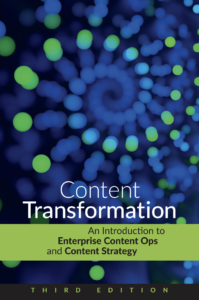Four real-world use cases for content reuse
Trying to eliminate costly content errors, increase brand consistency, and create content at scale? Consider content reuse.
What is content reuse?
Content reuse is when a whole or partial piece of information is used in multiple locations. For many organizations, this means copying and pasting content from one resource to another. However, this method becomes difficult to maintain when your organization has multiple authors and locations for storing content.
To increase the consistency of your content, you can reuse content from one managed source, like a component content management system (CCMS). In a single-sourcing scenario like this, you write content once, then reference that source content everywhere it’s needed. This is a powerful process for organizations that want to scale or globalize their content.
So, when is it time to consider content reuse? If the following scenarios ring true for your organization, you may be ready for a single-sourced content reuse system.
Case #1: You have content with life-altering information
Many organizations produce life-altering content. Think of organizations that deal with medical devices, heavy machinery, or manufacturing as a few examples. These industries typically have compliance requirements for content, such as required cautions or warnings. Clear, accurate documentation is critical to help ensure safe operation.
Copying and pasting content often results in inconsistency because of the opportunities for human error. (Where are the latest safety instructions again? What content needs the updated instructions? Where does all this content live?!) Companies that rely on copy and paste for content reuse are at a greater risk of delivering inaccurate information. Reusing content from a single source of truth increases your ability to keep critical content updated and accurate.
Case #2: You deliver core content to every customer
Organizations often need to deliver personalized content to their customers, such as feature-specific information for the product or service. However, there’s often core content that also applies across all offerings. Our course content for LearningDITA.com gives an example of core content vs. personalized content:
We’re looking at offering courses about component content management systems (CCMSs). The concept of “What is a CCMS?” will be the same for all of them. The process of “How do I check out files?” will be a little different for each of them. So, we might make two or five or 15 different courses, but there’s core content that would overlap.
– Sarah O’Keefe, LearningDITA: DITA-based structured learning content in action
Manually adding existing core content to personalized information wastes time and results in duplicate information being stored in different locations. Content reuse allows you to store the core content in one location and use it whenever you need it.
Case #3: You need consistency across content types
Companies share product specifications with stakeholders through multiple content types. Let’s use an example of a company with a software product. The staff needs product instructions and training content, and customers need product information and instructions. The company also needs marketing content to promote the product, and customers may also need support content to troubleshoot the software. If the company relies on copy and paste to borrow content from one place to another, they’ll end up with multiple–and sometimes conflicting–versions and variations. To ensure all users get the same information, no matter who they are or how they’re interacting with the organization, all content types must reference content from the same source.
Case #4: Your content requires cross-team collaboration
The more team members that need to be involved in the content creation, review, and distribution process, the harder it is to maintain consistent and accurate content without solid systems in place. This is especially true if you have subject matter experts (SMEs) and team members from other departments who are a fractional part of the content process, as they likely aren’t as familiar with authoring requirements as content staff.
Reusing content from a single source of truth creates a scalable process for integrating content from external authors. SMEs focus on authoring content that requires their expertise. Then, the content team pulls the content into the content management system to review, deliver, and reuse the content. Then, when future changes are needed, the SME only needs to update the content once, and the change is reflected everywhere the content is referenced.
Do any of these use cases ring true for your organization? Your organization might be ready for a content operations environment that’s built to reuse content from a single source of truth.
Use our calculator to estimate your ROI for content reuse, automated formatting, and more!
"*" indicates required fields


